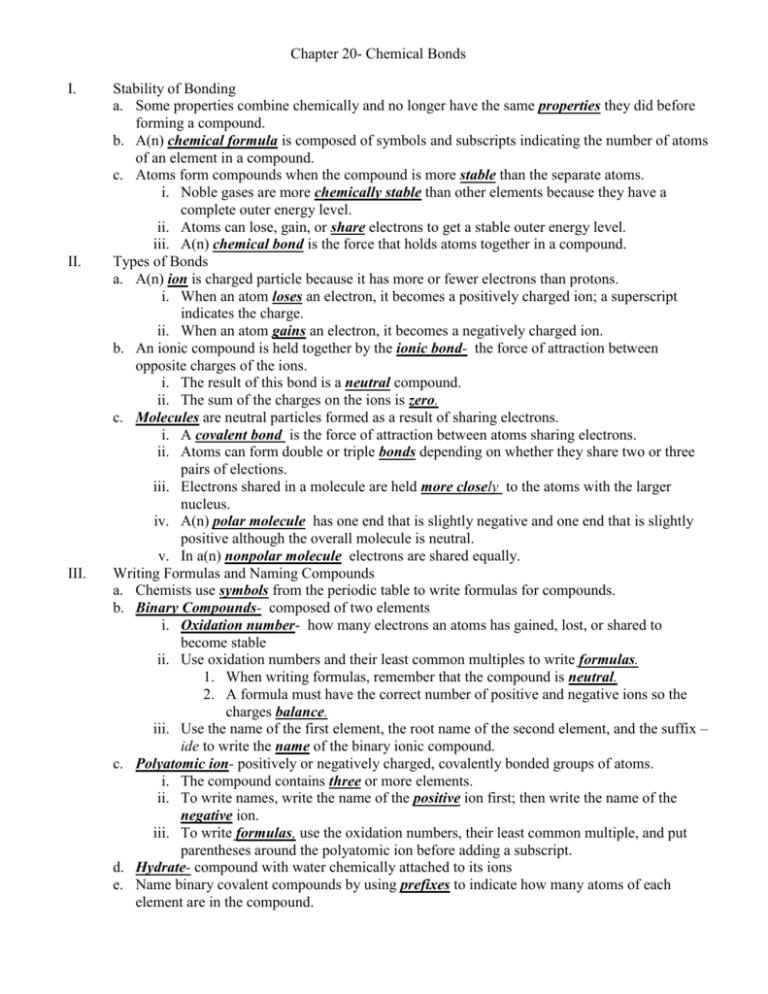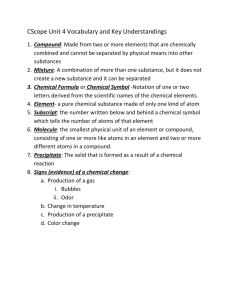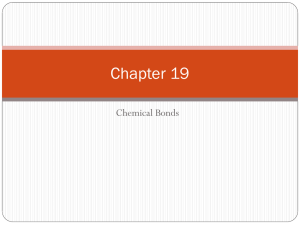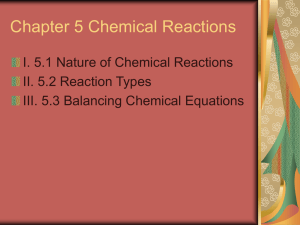Chapter 20- Chemical Bonds
advertisement

Chapter 20- Chemical Bonds I. II. III. Stability of Bonding a. Some properties combine chemically and no longer have the same properties they did before forming a compound. b. A(n) chemical formula is composed of symbols and subscripts indicating the number of atoms of an element in a compound. c. Atoms form compounds when the compound is more stable than the separate atoms. i. Noble gases are more chemically stable than other elements because they have a complete outer energy level. ii. Atoms can lose, gain, or share electrons to get a stable outer energy level. iii. A(n) chemical bond is the force that holds atoms together in a compound. Types of Bonds a. A(n) ion is charged particle because it has more or fewer electrons than protons. i. When an atom loses an electron, it becomes a positively charged ion; a superscript indicates the charge. ii. When an atom gains an electron, it becomes a negatively charged ion. b. An ionic compound is held together by the ionic bond- the force of attraction between opposite charges of the ions. i. The result of this bond is a neutral compound. ii. The sum of the charges on the ions is zero. c. Molecules are neutral particles formed as a result of sharing electrons. i. A covalent bond is the force of attraction between atoms sharing electrons. ii. Atoms can form double or triple bonds depending on whether they share two or three pairs of elections. iii. Electrons shared in a molecule are held more closely to the atoms with the larger nucleus. iv. A(n) polar molecule has one end that is slightly negative and one end that is slightly positive although the overall molecule is neutral. v. In a(n) nonpolar molecule electrons are shared equally. Writing Formulas and Naming Compounds a. Chemists use symbols from the periodic table to write formulas for compounds. b. Binary Compounds- composed of two elements i. Oxidation number- how many electrons an atoms has gained, lost, or shared to become stable ii. Use oxidation numbers and their least common multiples to write formulas. 1. When writing formulas, remember that the compound is neutral. 2. A formula must have the correct number of positive and negative ions so the charges balance. iii. Use the name of the first element, the root name of the second element, and the suffix – ide to write the name of the binary ionic compound. c. Polyatomic ion- positively or negatively charged, covalently bonded groups of atoms. i. The compound contains three or more elements. ii. To write names, write the name of the positive ion first; then write the name of the negative ion. iii. To write formulas, use the oxidation numbers, their least common multiple, and put parentheses around the polyatomic ion before adding a subscript. d. Hydrate- compound with water chemically attached to its ions e. Name binary covalent compounds by using prefixes to indicate how many atoms of each element are in the compound.








